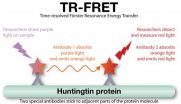(Press-News.org) A new light-based technique for measuring levels of the toxic protein that causes Huntington's disease (HD) has been used to demonstrate that the protein builds up gradually in blood cells. Published today (17th) in the Journal of Clinical Investigation, the findings shed light on how the protein causes damage in the brain, and could be useful for monitoring the progression of HD, or testing new drugs aimed at suppressing production of the harmful protein.
HD is a fatal, incurable, genetic neurological disease that usually develops in adulthood and causes abnormal involuntary movements, psychiatric symptoms and dementia. It is caused by a genetic mutation that results in the production of a harmful protein, called mutant huntingtin.
The research team, led by Professor Sarah Tabrizi of the UCL Institute of Neurology, was made up of scientists from UCL, the Novartis Institutes for Biomedical Research and King's College London. They used a new, ultra-sensitive test to measure how much of the harmful protein and its normal counterpart are found in blood cells from HD patients at different stages of the disease. The test, called TR-FRET, uses pairs of antibodies that stick to huntingtin molecules to absorb and emit light of different colours. This enables very tiny amounts of huntingtin to be detected with great accuracy.
The researchers found that levels of the harmful mutant huntingtin protein built up gradually over the course of the disease, from before the patients show any symptoms onwards. HD causes the brain to shrink more rapidly than normal, as measured using MRI scans. Surprisingly, the amount of mutant protein in white blood cells corresponded to the rate of brain shrinkage. This is the first time a blood test has been able to predict brain shrinkage in a neurodegenerative disease. Levels of the normal huntingtin protein, on the other hand, stayed constant throughout the disease.
The team went on to demonstrate that small fragments of the most toxic part of the protein were slowly building-up in the white blood cells - the first time this has been demonstrated in cells from human HD patients. If a similar process occurs in brain cells such as neurons, this finding may help explain how the damage gradually accumulates, eventually causing symptoms of HD.
This build-up of the mutant protein in the white blood cells of the immune system may also explain previous findings by Professor Tabrizi's team which showed that the immune system is hyperactive in HD.
"Measuring levels of the mutant protein using TR-FRET is a useful new tool in the fight against HD," said Professor Tabrizi. "We can now accurately study the most toxic form of the huntingtin protein in easily obtained blood samples from real patients. The fact that mutant huntingtin levels correlate with brain atrophy tells us we're dealing with something that's relevant to the process of brain degeneration in HD."
The new technique could also be an asset for forthcoming clinical trials of 'gene silencing' drugs that aim to suppress production of the toxic protein in the brain.
"Gene silencing drugs are very promising, but have significant potential for causing side effects, so we really need to know they're doing their job of lowering huntingtin levels," continued Professor Tabrizi. "This TR-FRET technique offers a way of showing that in real human samples, and we hope that it will help speed up the process of developing drugs that work to slow down this terrible disease."
INFORMATION:
Toxic protein build-up in blood shines light on fatal brain disease
2012-09-17
ELSE PRESS RELEASES FROM THIS DATE:
Results from study of Mead Johnson's Enfamil® Human Milk Fortifier Acidified Liquid published in Pediatrics
2012-09-17
[GLENVIEW, Ill., Sept. 17, 2012] – Mead Johnson Nutrition (NYSE: MJN) announced today results of a new study published in Pediatrics that shows Enfamil Human Milk Fortifier Acidified Liquid supports significantly higher growth in premature infants than powdered fortifiers and is well-tolerated. Enfamil Human Milk Fortifier Acidified Liquid is the first and only ultra-concentrated liquid human milk fortifier marketed in the United States that meets safety guidelines from the Academy of Nutrition and Dietetics (AND) and Centers for Disease Control and Prevention (CDC), as ...
Sorghum eyed as a southern bioenergy crop
2012-09-17
Sweet sorghum is primarily grown in the United States as a source of sugar for syrup and molasses. But the sturdy grass has other attributes that could make it uniquely suited to production as a bioenergy crop, U.S. Department of Agriculture (USDA) studies suggest.
Sorghum is an ideal candidate because of its drought tolerance, adaptability to diverse growing conditions, low nitrogen fertilizer requirements, and high biomass (plant material) content, according to molecular biologist Scott Sattler and collaborator Jeff Pedersen with USDA's Agricultural Research Service ...
Effectiveness and impact of climate change mitigation measures unclear
2012-09-17
Uncertainties relating to the assessment of effectiveness of emission reduction measures are considerable. In order to manage these, there is an evident need to develop uniform assessment methods for ensuring that the assumed emission reductions are also achieved in practice.
Significant mitigation of climate change is widely supported globally. Achieving the mitigation targets will require considerable reductions in global greenhouse gas emissions in the coming years. However, widely differing views, particularly of the large economies such as the EU, the United States, ...
Food industry's high-quality co-streams used effectively as raw material for new products
2012-09-17
Co-streams from the food industry are excellent sources of proteins and healthy oils for use in foods and cosmetics. However, at the moment these side streams are mainly used as fish and animal feed, for energy, or end up as waste.
Coordinated by VTT, the APROPOS (Added value from high protein and high oil containing industrial co-streams) project seeks to enrich several co-stream components at once from food quality co-streams of rapeseed/canola/mustard and fish. In particular, this project aims to promote the competitiveness of the SME sector and developing regional ...
VTT and GE Healthcare developing novel biomarkers to predict Alzheimer's disease
2012-09-17
Alzheimer's disease (AD) is a growing challenge to the health care systems and economies of developed countries with millions of patients suffering from this disease and increasing numbers of new cases diagnosed annually with the increasing ageing of populations.
Early detection of prodromal AD is vital both for assessing the efficacy of potential AD therapeutic agents as well as new disease modifying therapies are most likely to be effective when initiated during the early stages of disease. The elucidation of early metabolic pathways associated with progression to Alzheimer's ...
Your body doesn't lie: People ignore political ads of candidates they oppose
2012-09-17
COLUMBUS, Ohio - A recent study examined people's bodily responses while watching presidential campaign ads - and discovered another way that people avoid political information that challenges their beliefs.
In the last days of the 2008 campaign, researchers had people watch a variety of actual ads for Republican presidential candidate John McCain and his Democratic rival Barack Obama while the viewers' heart rates, skin conductance and activation of facial muscles were monitored.
The results showed that partisan participants reacted strongly to ads featuring their ...
Mobile phones and wireless networks: No evidence of health risk found
2012-09-17
There is no scientific evidence that low-level electromagnetic field exposure from mobile phones and other transmitting devices causes adverse health effects, according to a report presented by a Norwegian Expert Committee. In addition, the Committee provides advice to authorities about risk management and regulatory practice.
The Committee has assessed the health hazards from low-level electromagnetic fields generated by radio transmitters. These electromagnetic fields are found around mobile phones, wireless phones and networks, mobile phone base stations, broadcasting ...
At the right place at the right time -- new insights into muscle stem cells
2012-09-17
Muscles have a pool of stem cells which provides a source for muscle growth and for regeneration of injured muscles. The stem cells must reside in special niches of the muscle for efficient growth and repair. The developmental biologists Dr. Dominique Bröhl and Prof. Carmen Birchmeier of the Max Delbrück Center for Molecular Medicine (MDC) Berlin-Buch have elucidated how these stem cells colonize these niches. At the same time, they show that the stem cells weaken when, due to a mutation, they locate outside of the muscle fibers instead of in their stem cell niches (Developmental ...
Added benefit of Cannabis sativa for spasticity due to multiple sclerosis is not proven
2012-09-17
An extract from the plant Cannabis sativa (trade name Sativex®) was approved in May 2011 for patients suffering from moderate to severe spastic paralysis and muscle spasms due to multiple sclerosis (MS). In an early benefit assessment pursuant to the "Act on the Reform of the Market for Medicinal Products" (AMNOG), the German Institute for Quality and Efficiency in Health Care (IQWiG) examined whether the new drug, which is used as a mouth spray, offers an added benefit over the optimized standard therapy. However, no such added benefit can be inferred from the dossier, ...
Rapid intensification of global struggle for land
2012-09-17
The earth's limited surface is expected to stretch to everything: food for soon to be nine billion people, feed for our beef cattle and fowl, fuel for our cars, forests for our paper, cotton for our clothes. What is more, the earth's forests are preferably to be left untouched to stabilise the climate. Human ecologist and economist Kenneth Hermele will shortly be defending a thesis at Lund University, Sweden, in which he demonstrates that the struggle for land is intensifying rapidly.
Kenneth Hermele has conducted field studies in Brazil, where sugar cane has been cultivated ...

